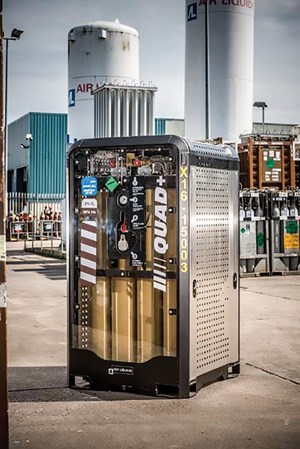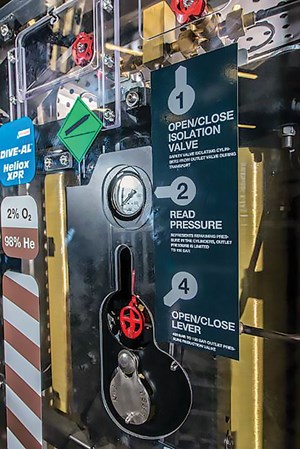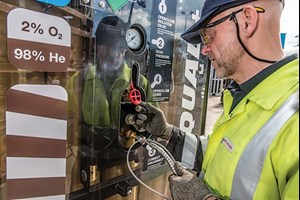An industry driver for safety
Oil and gas operators, and service providers, have focused a vast amount of time and effort on improving safety in every aspect of their business. Their approach to environmental risk preparedness and mitigation results from increased regulatory pressures, shifting economic conditions, and the public’s desire for more corporate social responsibility.
Organizations, including API and Oil and Gas UK, have led the initiative by developing safety guidelines and training services. These organizations serve the industry by providing companies with safety training, and act as a forum for discussing ongoing challenges.
Additionally, accrediting institutions designed to establish industry compliance standards for onshore and offshore operations have been created. For example, Det Norske Veritas and Germanischer Lloyd (DNV GL) provide a uniform set of rules and procedures, used in assessing the risk of underwriting individual vessels. Now, they are addressing another industry challenge, which is the need to reduce protruding objects from equipment that, potentially, could hurt personnel.
Air Liquide Oil and Gas Services (ALOS) has demonstrated its ability to develop new technologies that exceed safety compliance standards. As the industry continues to improve safety procedures, it is important to understand that the job is never truly finished. It is our duty to strive for the safest working environment possible by reducing, and ultimately preventing, the number of accidents in the workplace.

ALOS has a good history of complying with safety regulations, but we also strive to set new industry standards by rigorously testing, researching and developing new technologies at every stage of the product lifecycle.
PRESSURIZED GAS APPLICATIONS
In the upstream sector, operators deploy industrial gases in challenging and potentially hazardous conditions on a daily basis. These gases are used as blanketing agents to separate sensitive products from air. They also are used as purging agents in piping to prevent contamination. Applications include pipe fabrication, construction and commissioning/decommissioning of offshore infrastructures. They also are used in commercial diving for maintenance and repair of subsea structures, as well as in coiled tubing and underbalanced drilling.
ALOS has made safety a top priority and is committed to expanding industry safety standards while lowering costs. These factors, aligned with operator demand, were the guiding principles behind the introduction of the QUAD+ system in September 2015, Fig. 1. The system is now being used by operators and contractors to store and distribute gas in a safer, more efficient manner.
INCREASED TANK STRENGTH/STORAGE CAPACITY
QUAD+ reduces logistical costs by providing more gas per square foot of holding capacity than any similar technology of its size. The device has a working pressure of 450-bar, and is the first bundled tank system capable of safely containing such pressures. The ability to deliver 450-bar working pressure in a lightweight quad is made possible by using a high-strength fiber to wrap the cylinders. Until now, such pressure levels had only been available using heavy steel cylinders, where any benefit in providing higher pressure was negated by the heavier weight. The increased pressure gives QUAD+ a 40% greater capacity, compared to a standard 300-bar quad.
The higher pressure offers significant storage space savings, which help solve a common industry problem of limited deck space. There is also a faster decant speed, thereby improving flowrate. These features, combined with less refueling and moving requirements, significantly reduce logistical costs incurred through the deployment of more traditional models.
CONSTRUCTION AND TESTING
QUAD+ is made from several different types of corrosion-resistant materials. The frame is composed of galvanized steel coated with zinc, and its sides are constructed of stainless steel. The front and back panels are made of polycarbonate, which is well-known for its durable, stable properties. The see-through panels allow easy inspection of the cylinders and valves. The corrosion-resistant materials lower maintenance costs by reducing the need for regular recoating.

During pre-launch testing, blunt and sharp impacts on the side panels were induced to replicate vibration and/or shock with other materials that could occur onboard a vessel or platform. The robustness of the panels also was tested to ensure that the cylinders and valves are protected adequately. The extensive testing regime was preformed to comply with DNV2.7-1 and ISO10961 safety standards. In accordance with the DNV2.7-1, the quad remained upright during the 30° tilt test, which replicates heavy seas. During a vertical drop test (ISO 10961), conditions replicating rough handling were simulated without causing a gas leak in the manifold. In a rotational drop test replicating a fall from a truck, the quad again passed the test without a manifold leak or damage to the primary or side panels.
QUAD+ is constructed with paneling on all sides that reduces the possibility of snagging. Rounded/angled edges, recessed pad eyes and no extruding parts contribute to design safety and ensure safe transportation while minimizing handling issues.
OPERATIONAL EFFICIENCY
Harsh offshore environments expose personnel to extreme conditions, and their ability to work safely and effectively in these situations is an important factor. QUAD+ has been designed for safety and ease-of-use to allow for faster operations. A built-in pressure reducer prohibits outlet pressure from rising above 150 bar. This enables the user to deploy the same equipment that is available to connect to the quad, and eliminates the need for isolation valves between the cylinders, the outlet and the burst discs.

Interactions between the user and quad device have been enhanced to increase safety, with the introduction of a human machine interface, Fig 2. Operating the quad is simplified through clear labeling and easy-to-understand instructions. The operating instructions have been placed close to the relevant components, an improvement over the more-dispersed guides used on earlier designs. The manometer has been positioned at eye level, with the valves at shoulder height and the connections at the waist level (Fig. 3), while the operating lever clearly indicates on/off status to ensure no gas loss. The color-coding follows the D043 guidelines set by the International Maritime Contractors Association, which are widely accepted in the industry and diving sector.
An upgraded GPS track-and-trace system uploads the quad’s position to a satellite once a day. The up-to-date data improve efficiency and reduce costs by enabling the end-user to accurately locate each asset within a 24-hr timeframe.
HSE MENTALITY AND CULTURE SHIFT
ALOS developed the QUAD+ by drawing on its in-depth understanding of the market’s requirements to implement a solution that would reduce costs and enhance operational efficiency. Health and safety were primary drivers for the project. Its robust structure is fully compliant with multiple offshore safety standards, including DNV2.7-1, IMDG and ISO10961.
The gas storage and delivery system goes well beyond minimum safety requirements. It reflects a major shift in corporate mind-set to instill a proactive culture that sets new standards for developing technologies that intrinsically prevent injuries. ![]()
Safety culture and mentality shift traced back to OSHA initiative
Historically, the oil and gas industry has faced challenges in fully integrating a strong safety culture into its core business, and, on occasion, safety was seen as a separate compliance function with a more reactive approach. As an example, in the UK, industry safety professionals played an enforcement role by getting employees to obey the Occupational Safety and Health Administration regulations established in the mid-1970s.
They ensured compliance across the workplace and trained employees to adhere to the requirements. This involved enforcing the use of hard hats, safety glasses and other personal protective equipment, which was the primary focus of safety programs during that time.
We have come a long way and have made substantial progress. The industry culture of workplace safety is evolving, and more advanced technologies to monitor and prevent injuries and accidents are being created. This development extends to onshore and offshore environments, at quaysides and in the office. It is paramount that these procedures are implemented and enforced rigorously.
With the know-how and technology that the industry has at its disposal today, there are ample opportunities and capabilities to develop safer tools, procedures and systems on an ongoing basis.
As an industry, we have entered into a more demanding operational and economic environment, requiring all of us to be proactive and responsible. This is true of the culture at Air Liquide, which has been at the forefront of safety and innovation. Going forward, we will remain committed to helping create an even-safer industry for future generations. ![]()


